“Forged” through Love and Passing on the “Home Culture” for Millennia
2020-03-05 16:43:42
Editor’s Notes
The 44th Session of the World Heritage Committee will be held in Fuzhou, which will be the second Chinese city to host a World Heritage session after the 2004 session that was held in Suzhou. It is also the highest-level international conference on the conservation of natural and cultural heritage ever hosted by China. We are deeply honored to have the opportunity to host this conference.
As a renowned historic and cultural city, Fuzhou is known as the “Seaside Zou Lu (zou and lu are the respective birthplaces of Mencius and Confucius, and are a traditional metaphor for a land of culture and learning)” for its rich cultural and natural heritage. Fuzhou’s prolific culture has witnessed the struggles of the region’s early forebears throughout the ages, and is a testament to those periods in history. Fuzhou’s natural and cultural heritage constitutes the “root” and “soul” of the Mindu (Fuzhou as the capital of Min, the traditional one-character abbreviated term for Fujian Province) culture.
“Look to the past to learn about the future.” For the occasion of this grand event, this newspaper has launched a special issue titled “Natural and Cultural Heritage”, which will feature stories on those cultural relics and historical sites representative of Fuzhou from a wide range of perspectives, and bring the stories of Fuzhou’s time-honored history and splendid culture to a greater audience. By jointly passing on the Mindu culture, [we] hope to boost cultural confidence and contribute towards the development of Fuzhou into a land of blessings and a city of happiness in this new era.
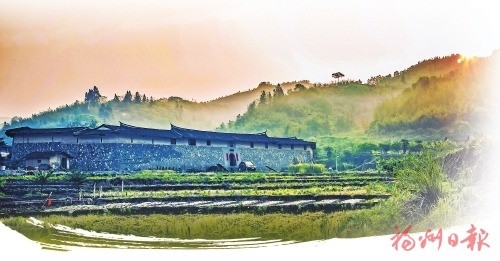
Shao’an Zhuang (Photo by: Zhang Peifen)
Scattered throughout the mountains and hills of Yongtai County are ancient zhuangzhai complexes (a type of traditional village stronghold that protects its inhabitants from external enemies) and ancient dwellings, which have survived despite the ravages of time. As defensive strongholds built in the countryside, the zhuangzhai complexes of Yongtai County play much the same role (albeit through different means) as Fujian’s tulou (literally “soil houses” or “clay houses”, which were favored by the Hakka-speaking Chinese), which also happen to be a world cultural heritage. Used as dwellings and defensive “fortresses”, these zhuangzhai complexes convey a “home culture” that had been formed over generations.
Discovery Files
As group dwellings unique to central Fujian, the zhuangzhai complexes of Yongtai originated in the Tang Dynasty (618-907), flourished in the Ming (1368-1644) and Qing (1644-1912) dynasties and had become popular in almost all villages and towns by the late Qing Dynasty (1840-1912). Surveys suggest that there are over 2,000 zhuangzhai complexes in total. Yongtai County has a total of 152 well-preserved zhuangzhai complexes. 98 of these structures cover an area of 1,000 square meters or more. There are few regions that can rival Yongtai’s zhuangzhai complexes, whether in terms of numbers or size.
At present, five of Yongtai’s zhuangzhai complexes have been recognized as major monunents protected at the national level, while 18 have been recognized as cultural relics protected at the provincial level. One of these monuments, Aijing zhuangzhai of Tongjing Town won the Award of Merit at the 2018 UNESCO Asia-Pacific Awards for Cultural Heritage Conservation.
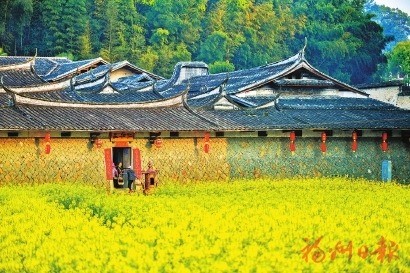
Renhe Zhuang (Photo by: Lai Zezhang)
Tracing Historical Origins
A Treasure Model of Chinese “Home Culture”
Narrator: Zhang Peifen, Vice Chairman of the CPPCC of Yongtai County and Director of the County Office for Village Protection
More than 1,000 years ago, during the Tang Dynasty, zhuangzhai complexes quietly mushroomed in Yongtai, and would later flourish during the Ming and Qing dynasties. More than 2,000 such complexes have made their way into historical records. Each of these imposing complexes is not only a cherished vehicle for traditional squire culture, but also for the collective memories of family settlements in the agricultural societies of the time. [In a sense], these complexes have become microcosms of the early budding of agricultural capitalism.
However, these complexes are not dwellings commissioned by wealthy squires in a prosperous land. The zhuangzhai complexes in Yongtai County arose during periods marked by warfare, banditry and resistance, during which they stood proudly erect as defensive structures among the green mountains of the Daiyun mountain range. During these tumultuous periods, these structures also gradually transformed into dwellings that played multiple roles, such as defense, residence, aesthetics, among many others.
An inside one is Zhuang while an outside one is Zhai; one with a civil atmosphere is Zhuang while one with a martial atmosphere is Zhai; one built by the father is Zhuang and one built by the son is Zhai; the residents call it Zhuang, while the outsiders call it Zhai; these are the essential characteristics zhuangzhai complexes in Yongtai County.
Generally, Zhuangzhai complexes are built on hills or hillside tablelands. Because these structures command a broad front view, a zhuangzhai complex is easy to defend and difficult to attack. The tall walls of a zhuangzhai complex are several meters thick, with lower sections of closely-laid marble and cobblestones, and upper parts sections built with compressed soil. The sturdy bases and somewhat thinner upper sections of their walls provide a zhuangzhai complex with exceptional defenses, not to mention that these walls are as high as over 10 meters.
“If Japanese pirates are not eliminated, the soldiers should be greatly ashamed. Fight the war of resistance to the end to reclaim our rivers and mountains.” These large Chinese characters are still engraved on the walls of Wan’an Fort in Songkou Town. On the west gate of Beishan Zhai, Baiyun Township, the scars of war are still clearly recognizable, a witness to the region’s turbulent history and an indelible mark of the resilience of the local residents and their love for their homeland.
Yongtai’s zhuangzhai complexes can be said to be poetic dwellings, with hidden codes buried in their architectural design. Their interiors are mostly decorated with “clear water-like plain sculptures” unique to the region instead of using oil-based paints, allowing the natural texture of the logs to be retained. The partition doors and sill windows seen everywhere have been carefully adorned by craftsmen with carved motifs that represent auspiciousness, wealth, and peace.
“Home culture” has taken root in these meticulously built residences passed down generation after generation. Most of these zhuangzhai complexes were built through the common efforts of entire families and clans. “Home culture” is deeply integrated into every aspect of these zhuangzhai complexes, including their walls and barriers, air shafts, lamp beams, pillar couplets and others. “Home culture” also plays the role of passing on ancestral virtues and family traditions from generation to generation. In Aijing Zhuang, Tong’an Town, the appreciation and respect of a homeowner for his wife Madame Li was generously inscribed on the main entrance to the zhuangzhai complex. The name “Aijing” (my beloved wife) advocates respect for women, and has allowed the complex to become one of the representative symbols of “female gentry culture” in ancient Chinese villages.
Furthermore, Yongtai’s zhuangzhai complexes were built by wealthy families and clans, whose forebears were nearly always immigrants. The building of these zhuangzhai complexes is a testament to their journey from rags to riches, as well as a historical record of the emergence and development of “agricultural capitalism” in these regions. The progressive management expertise and sound management systems crystallized in these complexes are a valuable subject for research, and still bear important lessons even to this day.
As a typical mountain community, Yongtai County experienced economic development that was very different from communities that make their homes in flat terrain. The clan system has also played an irreplaceable role in the development of this mountainous area. During the Qing Dynasty, mountainous Yongtai County already had a relatively well-developed commodity economy. The Dazhang Brook provided a convenient channel for waterway freight, allowing commodities such as agricultural products, handicraft, timber, and tea leaves to be sold to coastal cities or even exported overseas. In particular, Fuzhou had become Fuzhou was one of China’s “five ports of trade” by the late Qing Dynasty, which provided further impetus for the development of Yongtai’s commodity economy. This confluence of factors allowed Yongtai to accumulate the wealth needed for the construction of zhuangzhai complexes and the prosperity of its clans. The emergence of these zhuangzhai complexes also became an important mark of clan integration.
Over the long course of history, Yongtai’s zhuangzhai complexes have been a safe refuge because [their designers] have kept a wary eye on the distant future even during times of peace. Generations of clan descendants have remained sentimentally attached to these complexes, eventually turning them into “spiritual bastions”. Although Yongtai’s zhuangzhai complexes have long left behind the turmoil of yesteryear, their “home culture” has integrated China’s civilization, politics, folk religions, traditional etiquette and cultural life into an organic whole, becoming a fine example of “home culture” not only in Fujian, but across the whole of China, that has been treasured and preserved for generations.
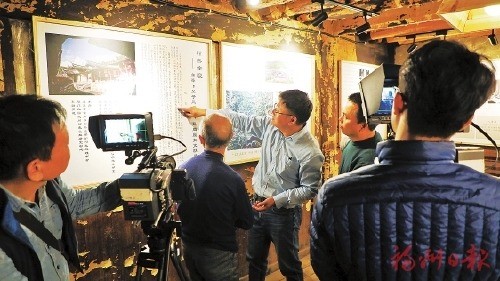
A CCTV crew filming a feature on Yongtai’s zhuangzhai complexes for the “Wisdom of Traditional Chinese Architecture” inJishan Hall (Photo by: Zhang Mingzhen)
Cultural Continuity
A peek behind the veil of Yongtai’s zhuangzhai complexes
The history and culture of Fuzhou can be traced back 7,000 years, while the city proper has a history of over 2,200 years. Many of its historic buildings have been preserved to this day. Because Yongtai’s zhuangzhai complexes are one of the major forms of Fuzhou ancient houses (also known as gucuo), their conservation and development have been given great priority by the provincial, municipal and county governments. Conservation efforts have proceeded orderly and steadily, and have achieved remarkable results.
In 2015, Yongtai County established the Office of the Leading Group for the Conservation and Development of Ancient Villages and Ancient Zhuangzhai Complexes (“County Office for Ancient Village Conservation”). The office plans to allocate CNY 20 million each year to to the restoration of zhuangzhai complexes and lists the conservation of zhuangzhai complexes as a major item on the agenda.
Shortly after its establishment, the office embarked upon a survey of the county’s cultural monuments to be placed under official protection, and found that there are 152 well-preserved zhuangzhai complexes, 98 of which are more than a century old, and cover an area of more than 1,000 square meters. However, these complexes were in states of severe disrepair, and were in urgent need of restoration. Through public education, local villagers gradually came to take pride in conserving rather than demolishing the local zhuangzhai complexes.
In 2016, the Yongtai Zhuangzhai Cultural Heritage Protection Seminar was held. Renowned experts and scholars of cultural relics, architecture, archeology, and world heritage conservation visited more than 10 zhuangzhai complexes, including the Hecheng Zhai and Zhongpu Zhai. They discussed issues regarding cultural heritage conservation and inheritance, clearly defined their value as cultural heritage and proposed clear directions and means for the conservation and development of Yongtai’s zhuangzhai complexes.
These huge and complex ancient dwellings are not only difficult and expensive to restore; there are also complicated issues with regards to property rights. To deal with this situation, Yongtai mobilized 38 main zhuangzhai complexes to establish protection and development councils. This has promoted unity among various clan members, promoted cooperation with the government, and enabled both sides to jointly work towards the conservation of zhuangzhai complexes. This has pooled the wisdom, strength and capital of the people to form a strong framework for the conservation and development of the zhuangzhai complexes.
Under the leadership of the councils, the people of all clans follow the principle of “no design, no bidding, no external invitation and no external purchase”, having enabled a five-fold effect for each Chinese yuan spent. In recent years, more than 30 key zhuangzhai complexes have basically retained their structural integrity, with close to zero leakages or collapses.
Greater popularity is the key to “reviving” zhuangzhai complexes. In 2018, the Conference for the Revival of Chinese Villages · Yongtai Summit was held in Zhutou Zhai, Baiyun Township. Over 500 participants from the United States, Thailand, as well as 16 Chinese provinces and cities, attended this gathering to promote the revitalization of the countryside. The summit not only further unveiled the hidden mysteries of Yongtai’s zhuangzhai complexes, but also brought the latest developments in rural development [strategies] to Yongtai, and established linkages between such resources as homestay proprietors, colleges and universities, thus promoting rural revitalization.
Beishan Zhai in Baiyun Township became the zhuangzhai complex in Yongtai to be converted into a hotel, Ningyuan Zhuang in Songkou Town became a museum for ancient weapons, while the Judges Studio for the Protection of Ancient Zhuangzhai Complexes was established in Zhutouzhai Village, Baiyun Township... Through openness and interactions with the outside world, Yongtai has gradually promoted the cultural brand of its zhuangzhai complexes.
In September 2019, Yongtai was included in the first batch of national whole-region tourism demonstration zones. Through this occasion, Yongtai integrated the revitalization of ancient villages and zhuangzhai complexes into the development of its whole-region tourism, pioneered the development of tourism routes in zhuangzhai complexes in Tong’an Village, created intellectual property rights related to zhuangzhai complexes, and positioned these villages as cultural tourist attractions. Yongtai County is also fully tapping the cultural connotations of zhuangzhai complexes, and creating a “home cultural habitat” in Yangwei Village, Tong’an Town by promoting family traditions and family etiquettes.
Provincial and municipal experts have made several visits to Yongtai for field surveys and have expressed their approval for the conservation and development measures that have been implemented. In 2018, Fuzhou issued a three-year tourism action plan, which includes such aspects as tapping Fuzhou’s zhuangzhai complex culture, and promoting the conservation and development of zhuangzhai complexes. The action plan aims to complete special conservation plans for historic buildings in Yongtai, including the zhuangzhai complexes, within one year and develop characteristic zhuangzhai complex tourist products.
In addition, Yongtai will focus on building a whole-region tourism spatial pattern featuring “one core, one belt and five areas”, and create five major tourist areas, such as the ancient town’s ecological culture, zhuangzhai complexes’ religious culture, countryside vacations, among others.
The conservation of cultural relics today will benefit generations to come. After five years, Yongtai’s experience with the conservation of its zhuangzhai complexes has provided lessons that may be promoted and results that may be replicated in other regions throughout Fujian province.
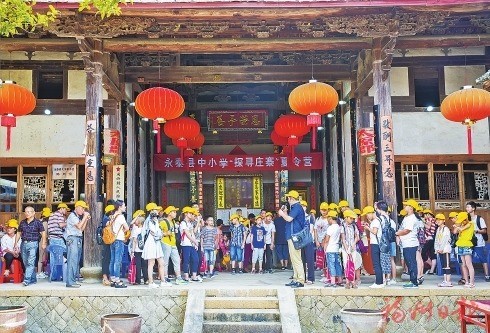
Shengping Zhuang (Photo by: Wu Zhaohui)
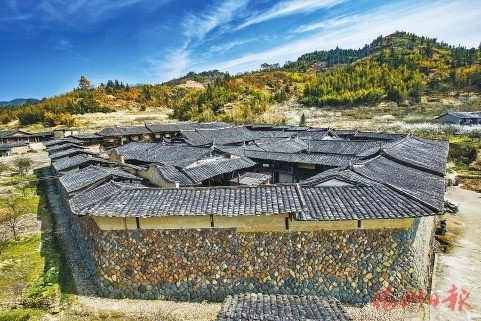
Zhongpu Zhai (Photo by: Zhang Peifen)
Expert Commentary
Chief Expert of China Society for Urban Studies Bao Shixing:
Rural settlements are places where villagers have settled down for generations. As a result, we should approach our research from a holistic and macro perspective. The zhuangzhai complexes of Yongtai are fully tailored to local conditions and the local terrain. Their building materials, such as stones and rammed earth, originate from local sources, reflecting their energy-saving and eco-friendly characteristics. The perfect integration of the artificial and natural environment also provides us with a rare example for in-depth research on Yongtai’s rural society in the 19th century.
Xu Songling, researcher at the Chinese Academy of Social Sciences and counselor of the Counselors’ Office of the State Council:
The zhuangzhai complexes of Yongtai are different from [traditional dwellings] in other traditional villages, including ethnic villages. From a functional perspective, most villages provide a living space, while Yongtai’s zhuangzhai complexes play dual roles as both dwellings and defensive structures. The “defense function” of Yongtai’s zhuangzhai complexes is mainly reflected through their anti-bandit defenses, which explains the emphasis on strong enclosing walls. This also reflects a “civil defense system”. Compared with tulou (Hakka Houses), zhuangzhai are not only different in shape and structure, but also larger and richer in function. Cultural heritage research that focuses on this aspect will establish a new understanding different from and more developed than the current state of heritage research.